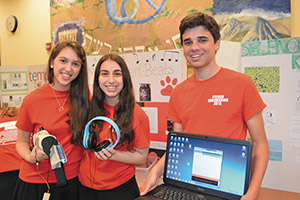

PARAMUS, NJ—Ally Weiss is only 15 years old, but this Frisch School freshman has already created a remote-control car with a robotic claw that can help mobility-impaired people pick things up from the floor. Working together with fellow freshman engineering students, Ben Moskowitz and Evan Zauderer, Weiss developed a coding system that allows the user to move the car and to open its claw with simple hand and finger motions.
Weiss’ project was displayed along with dozens of other innovative designs at The Frisch School’s Annual Science and Engineering Symposium this past Thursday night, May 28, at its campus in Paramus.
“Frisch’s engineering program has been an overwhelming success,” said Principal Rabbi Eli Ciner. “Just a few years ago it would have been impossible for yeshiva high school students to have an opportunity for a hands-on engineering education. Now we have a dedicated lab space and are churning out innovative products that display the Frisch students’ coding skills, creativity and computer knowledge.”
Weiss said she really enjoyed the learning process. “It was such a fun experience,” she said. “I’ve never done anything like this before.”
Mrs. Rifkie Silverman, chair of the engineering department and instructor of the engineering classes, said, “The students work in teams and oversee every aspect of the projects. The program is truly experiential learning at its best!”
To kick off the evening’s event, Susan Engelhardt, the executive director of The Center for Innovative Ventures of Emerging Technologies at Rutgers, addressed the Frisch parent and student body. She spoke about the need for engineers to clearly identify a problem and solution, as well as the presence of a focused market for innovations.
Each of the Frisch student innovations had been created with a specific problem in mind. Among the projects were a pacifier that can also take a baby’s temperature, a walker that can climb stairs, an LED display that shows moviegoers which seats are available in a dark theater, a lock for a gun that only lets the shooter use it when sober, a lock that uses radio frequency proximity sensors and randomized reprogrammable security systems to avoid the religious issues involved with electronic locks in hotels on Shabbat and a glove that detects and interprets the wearer’s sign language and converts it into verbal communication and text.
Frisch freshman Gabriella Wolf created a bracelet that measures the sun’s UV rays and can detect when its user needs to reapply sunscreen. Wolf, who worked in collaboration with freshmen Gavriel Brody and David Zenou, said that she enjoyed the process immensely. “It was really cool seeing an idea that just existed on paper, be created into an actual prototype,” she said. “At the beginning of the year I never would have thought I could do anything like this. It has been an amazing learning experience.”
In addition to the engineering projects, Thursday night’s symposium also showcased individual biomedical research projects of the junior class—elected to participate in the Waksman Student Scholars Program run in collaboration with Rutgers University and funded by the National Science Foundation. Embracing the philosophy that “the best way to learn science is to do science,” students in this program had the opportunity to engage in an authentic research project that involved deciphering the genome of an aquatic plant called Landoltia punctata. This plant is of interest to scientists because of its ability to achieve bioremediation, sequestering toxic metals from the water in which it is grown as well as for its potential to serve as an alternate source of biofuels. During this class, students mastered both state-of-the-art techniques for isolating genes as well as the complexities of bioinformatics using a sophisticated computer program aimed at analyzing novel DNA sequences. The students’ research data is being published on the world-wide databases of the National Center for Bioinformatics.
“One of the most rewarding parts of the program is to witness the intellectual growth of the students as they become independent learners and real scientists, reveling in their successes and learning from their mistakes,” said Dr. Mindy Furman, chair of Frisch’s science department and head of this program.
Gabriel Dardik, a participant this year, stated, “If I could take one class this year, it would be the science research elective. I’m still surprised that, as a high school student, I was able to identify a protein in plants involved in the ability of the plant to fight off fungal infections.” A similar sentiment was echoed by fellow student Jared Auslander who identified a protein, seleonprotein K, whose function in humans has to do with the immune system but whose function in plants is still unknown. For most of the students, this class was their first exposure to a genuine laboratory setting. As Benji Schwartz exclaimed, “I came away having learned more than I ever expected.”
The evening wrapped up with a demonstration of a 3-D printer by Konica/Minolta, giving all who attended a look at the future of 3-dimensional printing at Frisch. The school plans to acquire a new and improved 3-D printer in addition to its present smaller version for this coming school year. According to Mrs. Silverman, “A new high-quality 3-D printer will enable students to print their custom designs, enhance their projects and further propel innovations at Frisch.”










